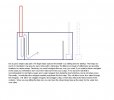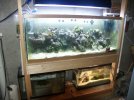what is a refugium (I understand it's another type of sump set-up)?
In the strictest sense a refugium is refuge for critters that wouldnt survive in the main tank due to predation from other main tank inhabitants.
Originally refugiums were designed to be viewable and were often considered an addition to a main tank. An example of this would be a 20 gallon sea horse tank plumbed into a 80 gallon reef tank.
However many people also saw how pods, (amphipods, copepods, etc small crustaceans which many fish find good eating, and the larvae are a good source of plankton for many corals. Think food farm for your tank) multiplied faster and consequently fed the tank more often if given a safe haven...so a refugium also came to be a home for pods.
To further the home for pods concept, people started putting macro algae in the refugium in order to compete w/ the annoying micro algae that causes problems in reef tanks. The macro algae uses the same nutrients needed by the undesirable algae, thereby depriving it of food for growth. Along the way refugiums became less attractive, (what w/ being stuffed full of algae and pods...) that they have become relegated to being under the sump w/ the rest of the equipment that keeps the tank pretty and working.
If using a refugium for nutrient export, (macro algae takes up phosphate and nitrates, then gets "pruned back" and thrown out, thereby "exporting" the nutrients that encourage algae growth), then slower flow, allows more contact time w/ the available nutrients. The reccommended circulation rate is roughly 10x the tanks volume per hour...eg 100 gallon tank should have at least 1000 gallons an hour flowing through it. However many people have realized that their corals do better when subjected to more flow, and a chaotic flow pattern. This more closely resembled the swirling currents on a reef in the wild. I know many people who go upwards of 15-20x their tanks volume per hour. Having 1000 gallons per hour flowing thru your sump would be very noisy, (trust me, the wife would complain. It would sound pretty close to a toilet flushing constantly). so you probably would want to slow the flow through your main sump to lower noise levels. I would say between 3-7 x your tanks volume would be fine. Remember the sump gives you a place to keep your mechanical filtration...micron socks or filter floss will collect alot of crap. Detritus is a polite word for fish crap...it also covers uneaten food, and anything thats busy polluting the tank. You want this stuff gone..it will poison your tank. The best way to make your tank successful is to think of it as a toilet, it needs to be flushed constantly, otherwise you've got a big mess. Mechanical filtration is one piece of the toilet flushing. Water changes are another...make sure you can do water changes easily. It wont keep you from doing them then. I dont care what anyone says, water changes are necessary and will need to be done...
why do I need to keep the refugium from being the most effective?
I think I've pretty much answered this one up above, but just in case, you actually want your refugium to be MORE efficient. This is why I like them seperate from the main sump. I've plan on going approximately 7x turnover in tha main sump, and 2-3 x turnover in the refugium of my upcoming tank.
Remeber how we said earlier that more flow was better, but you didnt necessarily want all that thru your sump? A closed loop is how you get more flow thats not in your sump. A closed loop is a flow system that exists soley for the circulation. Picture a drain from your tank that goes straight into a pump, (no sump involved) and gets blown back in to the main tank just to circulate water more. Thats it....so if your sump handles 5x turnover, and your closed loop handles 5x turnover, you've got your 10x turnover w/o all the noise. There are many ways to do a closed loop....My plans are on this thread here....
http://www.reefsanctuary.com/forums/showthread.php?s=&threadid=229&perpage=15&pagenumber=1
This can give you an idea on how to do it.
I was thingking of getting a MAG 12 for my return pump (about 950 gph).
No problem, just realize that those rating are generally @ 0 head, (meaning no plumbing attached.) Everytime you add right angles to your plumbing, or you increase the height the water column must travel, (head) you increase pressure, which decrease water flow rates.....not insurmountable, just requires more planning.
Hope this all helps,
Nick


